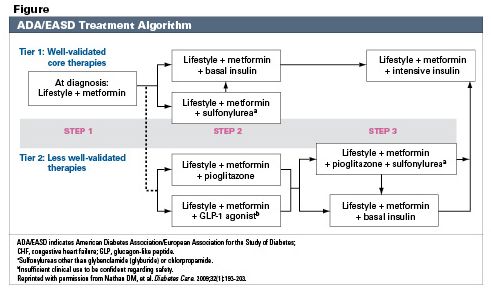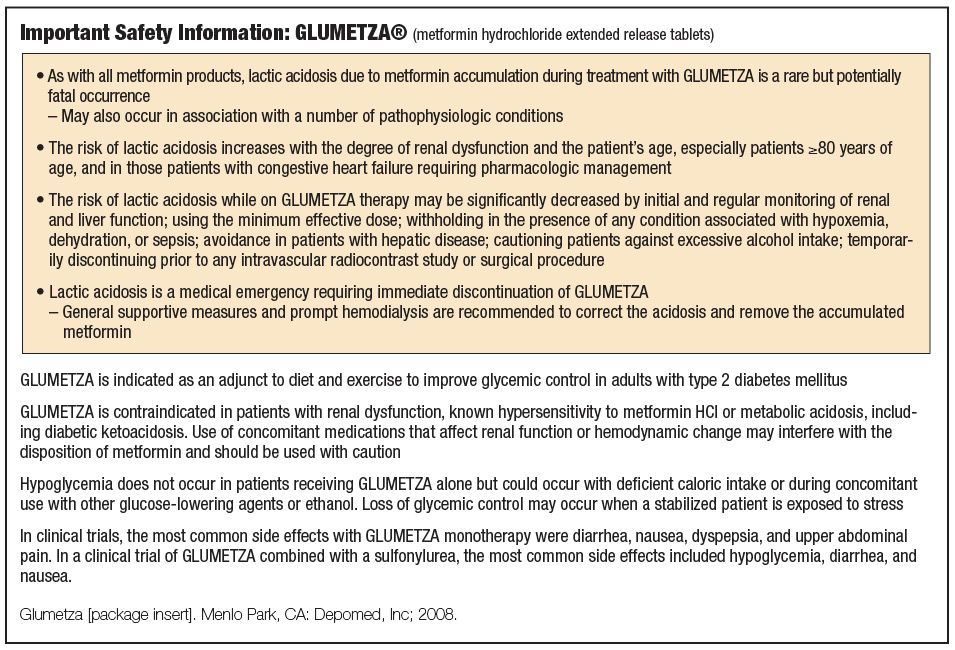First-Line Pharmacologic Treatment for Type 2 Diabetes: Optimizing Metformin Therapy
This article will briefly discuss some of these issues, including treatment of diabetes (focusing on the initial treatment choices) and individualization of therapy and adherence, and will introduce an extended-release metformin dosage form, Glumetza.
This article is brought to you by

John R. White Jr, PA, PharmD, is Professor, Department of Pharmacotherapy, College of Pharmacy, at Washington State University in Spokane, Washington.
Type 2 diabetes is an epidemic in the United States. The most recent estimates suggest that 7.8% of the population has diabetes.1 This translates into almost 18 million with diagnosed disease and about 6 million with undiagnosed disease. Additionally, an estimated 57 million people have prediabetes; each year, approximately 1.6 million individuals older than 20 years of age will convert from prediabetes to overt disease.1 The majority of patients (90%-95%) with diabetes have type 2 disease. In the past few years, a plethora of diabetes medications have been introduced. This has been very positive from a treatment perspective but has also caused much confusion. This article will briefly discuss some of these issues, including treatment of diabetes (focusing on the initial treatment choices) and individualization of therapy and
adherence, and will introduce an extended-release metformin dosage form, Glumetza.
There are 2 primary sets of treatment guidelines for the management of type 2 diabetes. One set is published by the American Diabetes Association (ADA) in collaboration with the European Association for the Study of Diabetes (EASD)2; the other is by the American Association of Clinical Endocrinologists (AACE) and the American College of Endocrinology (ACE).3 Although there is a great deal of consistency between these 2 guidelines, there is also inconsistency of goals and suggestions regarding achievement of these goals. Because discussion of these nuances is beyond the scope of this article, the ADA/EASD guidelines and algorithms are cited, and the reader is referred to the reference for the AACE/ACE recommendations.
Glycemic goals for patients with type 2 diabetes include A1C levels of ≤7%, premeal glucose levels of 70 to 130 mg/dL, and postmeal levels of <180 mg/dL.3,4 The ADA/EASD treatment algorithm is shown in the Figure.

Two consistent components of the treatment algorithm are the inclusion of lifestyle improvements and the use of metformin. Metformin is recommended from the time of diagnosis throughout the course of the disease (unless a contraindication is present). It should be noted that the AACE/ACE guidelines also rely heavily on metformin as a drug of first choice, although more options are provided.
Product Selection and Individualization of Therapy
Many factors must be considered when choosing an antihyperglycemic medication, including degree of glycemic lowering needed to attain target goal range, effect of the medication on weight and lipid profiles, contraindications, side effects, cost and patient insurance coverage, and potential level of adherence to the regimen.5 Considering these issues, it is evident why metformin is recommended in almost all cases as a first-line agent. First, the typical level of glycemic lowering with metformin (˜1.5% reduction in A1C) is among the highest of the oral agents.5 Second, metformin is associated with weight loss and an improvement in lipid profiles.5 Third, it is one of the least expensive oral antihyperglycemic agents. Contraindications, however, must be observed (particularly renal and/or hepatic dysfunction). While metformin is sometimes associated with gastrointestinal (GI) side effects, this can usually be mitigated via appropriate titration and dosing prior to meals. One of the potential problems with metformin is that the conventional dosage form is given in 2 to 3 daily doses. Numerous studies show that compliance is inversely proportional to the number of daily doses required.6 For example, when the daily doses of medication increase from 1 to 4, compliance drops from about 80% to approximately 50%.6 It is well documented that nonadherence to diabetes medications is associated with higher costs, more frequent hospitalizations, and even higher mortality rates— a significant issue that needs to be considered.6 Currently, there are several single daily dosage forms of metformin available in the United States, including Glucophage XR, Fortamet, and Glumetza.
Role of Glumetza (Extended- Release Metformin) in Diabetes Management
Delivery System
Glumetza utilizes a polymer delivery technology formulated into an oral tablet.7 This system provides a sustained delivery of active drug to the site of absorption (the small intestine) and mitigates drug load delivered to the large intestine, where it is not absorbed. During the first 15 minutes after dosing, the tablet absorbs fluids in the stomach and expands. The enlarged tablet remains in the stomach for 8 to 9 hours; during this time, the active drug is diffused into the GI tract, where it is absorbed from the small intestine. This process continues for approximately 15 hours postdose, then the tablet disintegrates and the excipients are excreted. Glumetza is available as a 500- or 1000-mg tablet.8 Because of subtle differences in formulation, the 500- mg tablet may be excreted as a soft hydrated mass, while the 1000-mg tablet may be excreted as an insoluble shell.8 Patients should be warned of this possibility and should also be counseled not to break or crush the tablets prior to taking them.8
Efficacy and Tolerability
Glumetza has been studied in phase 3 trials as monotherapy, in combination with sulfonylureas, and in combination with insulin.8 Both pharmacokinetic and efficacy studies of Glumetza dosed once daily have demonstrated that the amount of drug delivered to the plasma and the glycemic-lowering potential are similar to conventional multiple daily dosed metformin. It is reasonable to assume that Glumetza, similar to conventional metformin, could be used in combination with other antihyperglycemic agents as well.
Adverse effects with Glumetza are very similar to those observed in patients treated with conventional metformin and are primarily GI-related. These side effects can, to a large degree, be circumvented by appropriate titration.2 Additionally, a study has reflected improved tolerability associated with Glumetza compared with conventional metformin.
Safety and Monitoring
The same precautions observed with conventional metformin also apply to Glumetza. As with all metformin products, lactic acidosis due to metformin accumulation during treatment with Glumetza is a rare but potentially fatal occurrence. Patients should not take Glumetza if they have significant renal (serum creatinine ≥1.5 mg/dL for males or ≥1.4 mg/dL for females) or hepatic dysfunction. Patients should not receive Glumetza if they are undergoing a surgical procedure, require radiocontrast dyes or any other medications that may adversely affect renal function, consume large quantities of alcohol, or experience states of hypoxia.7 These contraindications are all followed to avoid the potentially fatal side effect of lactic acidosis. Recent studies have suggested that metformin is safe unless the glomerular filtration rate drops below 30 mL/minute; however, most recommend not using metformin if creatinine clearance is <60 mL/minute.2,3 Metformin is rarely associated with megaloblastic anemia secondary to a reduction in vitamin B12.8 If this occurs, the patient can be managed with supplemental vitamin B12.3
Dosing
Glumetza is dosed once daily.8 All dosage regimens must be individualized and are ultimately contingent upon the patient’s level of glycemic control and response to Glumetza and other antihyperglycemic medications. Most patients should be initially treated with Glumetza 1000 mg, taken with the evening meal. The dose can be gradually titrated upward (increased weekly in increments of 500 mg) to a maximum of 2000 mg daily. This titration schedule may reduce the likelihood of GI side effects and may also allow for determination of glycemic response. Patients previously treated with conventional metformin therapy may be switched to Glumetza therapy at the same total daily dose (up to 2000 mg daily). In this situation, patients should be counseled to closely monitor their blood sugar.
Conclusion
While there is significant debate regarding specific treatment algorithms for patients with type 2 diabetes, most experts agree that metformin is, in most cases, the first medication that should be initiated, and one that is usually continued for many years. Metformin is efficacious, generally well tolerated, and very cost-effective. The major drawback with conventional metformin therapy is the requirement for multiple daily doses and dose escalation—related GI side effects. This patient adherence barrier may be overcome by use of Glumetza, an extended-release dosage form of metformin that is administered once daily and may be titrated more effectively to reduce GI side effects and maintain tolerability.




